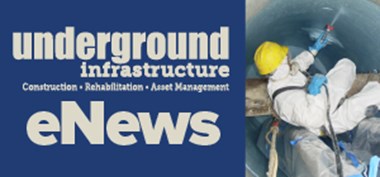TTC to Release CIPP Emissions Safety Findings on Dec. 17
HOUSTON (UC) — The Trenchless Technology Center (TTC) at Louisiana Tech University said it has completed a study on the safety of styrene emissions from cured-in-place pipe (CIPP) and will present its findings and recommendations in a webcast on Dec. 17.

The TTC research was funded by NAASCO in response to published reports that raised safety concerns about styrene emissions during the CIPP installation process. The research was conducted in two phases:
Phase 1 was a four-month study which focused on the review of published literature pertaining to chemical emissions during CIPP installations using styrene-based resins. That phase was completed on April 6, 2018, by researchers at the University of Texas at Arlington's (UTA) Center for Underground Infrastructure Research and Education (CUIRE), and the Institute for Underground Infrastructure (IKT) in Germany.
It found that existing studies do not adequately capture worker exposures or levels in the surrounding areas to which workers or citizens may be exposed. The team further determined that spatial variation of concentrations, and variations in concentrations with different meteorological conditions, are not well determined.
Phase 2, a larger, in-field study conducted by TTC, recently concluded, and its findings will be shared via webinar on December 17, 2019. Online webinar registration is open to all.
The year-long second phase included measurement of styrene and other organic compounds at multiple CIPP installation sites across the country, representing different pipe diameters (8”, 12”, and larger) and lengths, in order to capture variation in emissions.
Measurements were conducted before, during, and after curing at the termination manhole, TTC, as well as various locations in the surrounding outside area and inside nearby buildings. Worker exposure was also measured via personal exposure monitors. Finally, dispersion modeling was conducted to estimate compound concentrations at different locations for a wide variety of meteorological conditions.
Measured and modeled concentrations were compared to appropriate health-based action levels to determine if any potential health risks exist for workers or citizens in the surrounding communities, TTC said.
Related News
From Archive

- Glenfarne Alaska LNG targets late-2026 construction start for 807-mile pipeline project
- U.S. water reuse boom to fuel $47 billion in infrastructure spending through 2035
- $2.3 billion approved to construct 236-mile Texas-to-Gulf gas pipeline
- Major water pipe break in Puerto Rico hits over 165,000 customers
- Potomac River Tunnel project enters construction phase beneath Washington, D.C.
- Pennsylvania American Water launches interactive map to identify, replace lead water service lines
- Trump's tariffs drive $33 million cost increase for Cincinnati sewer project
- Utah city launches historic $70 million tunnel project using box jacking under active rail line
- Tulsa residents warned after sewer lines damaged by boring work
- Fatal trench collapse halts sewer construction in Massachusetts; two workers hospitalized



Comments